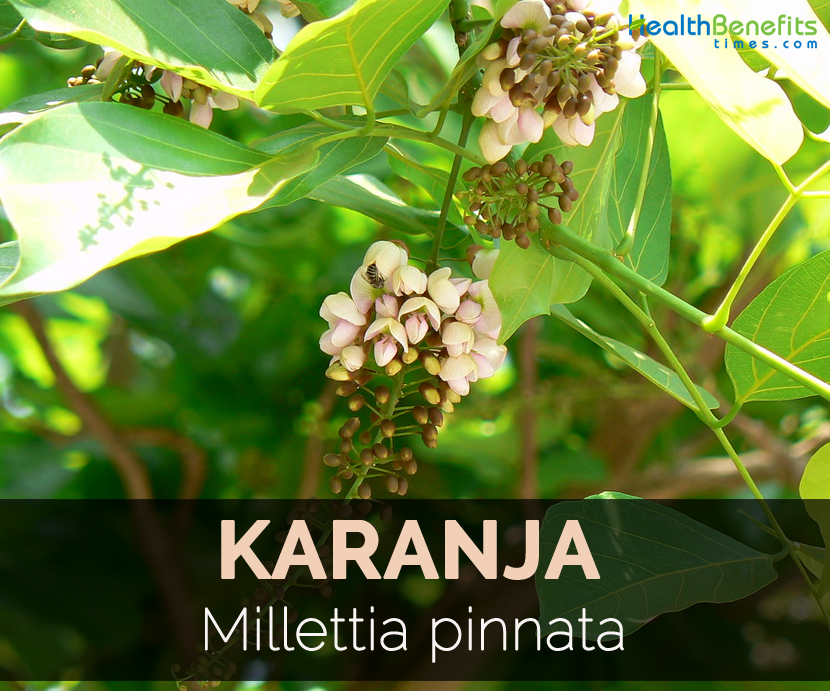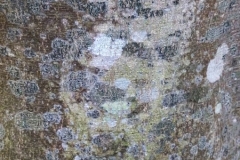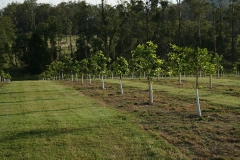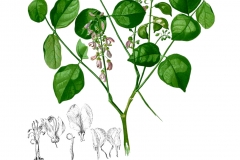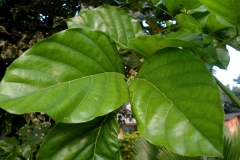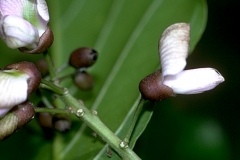| Karanja Quick Facts |
| Name: |
Karanja |
| Scientific Name: |
Millettia pinnata |
| Origin |
Tropical and temperate Asia including parts of Indian subcontinent, China, Japan, Malaysia, Australia and Pacific islands |
| Colors |
Brownish-red |
| Shapes |
Flattened, transversely elliptical, 1.5-2.5 centimeters (0.59–0.98 in) long |
Karanja is a tree or shrub which is broadly distributed from India through central and south-eastern Asia, northern Australia and Indonesia. It stands in wide range of soils including saline soils. The plant occurs naturally in lowland forest on limestone and rocky outcrops on the coast. It is a medium sized fast growing tree growing 15 to 25 meters tall with drooping or spreading branching habit and broad crown. Bark is grey-brown or grey and smooth or with faint vertical fissures. Leaves are hairless and pinkish-red when young that turns to glossy green above and dull green with prominent veins below when matured. Flowers are 2-4 clusters, pea shaped, short stalked and about 15-18 mm long. Calyx is truncate (4-5 mm long), campanulate and finely pubescent. Corolla is white-pink and purple inside with brownish vein on outside and five toothed. Pods are flattened, smooth, oblique-oblong to ellipsoid, 3–8 cm x 2–3.5 cm x 1–1.5 cm. Pods consists of 1 to 2 brown, thick walled, leathery to sub woody seeds. Seeds are elliptical or compressed with brittle coat (1.5–2.5 cm x 1.2–2 cm x 0.8 cm), dark brown and oily.
Plant description
The tree is medium-sized, evergreen or briefly deciduous usually 8 meters tall but reaches 15 to 25 meters. Trunk is crooked or straight about 50 cm in diameter which is covered with grey-greyish brown bark usually smooth or vertically fissured. It has deep and thick taproot having several secondary lateral roots. Branches are drooping or spreading and forms a broad hemispherical crown of dark green leaves. Branchlets are hairless with pale stipule scars. Leaves are alternately arranged along the stems. Leaves are pinnately compound, alternate and consist of 5-7 leaflets that are glabrous and borne in 2 or 3 pairs and a single terminal one on slender stalks. Leaflets are ovate-elliptical, pointed at tip and about 5-10 cm long and 4-6 cm wide. An inflorescence is 6-27 cm long raceme of papillonaceous and fragrant flowers. Flowers are pink white, lavender in color, pubescent and about 15-18 mm long. Flowers are followed by fruits. Fruits are elliptical pods about 3-6 cm long x 2-3 cm broad. Pods contain 1 to 2 seeds which resembles bean. Seeds measures 1.5-2.5 cm long x 1.2-2.0 cm wide and is dark brown.
Traditional uses
- Plant is useful for hemorrhoids, dyspepsia, skin diseases, hemorrhoids, bronchitis, rheumatism, herpes, cough, sores, spleen enlargement, diabetes, ulcers and sores.
- The juice extracted from roots is used to clean teeth.
- Use it externally as a liniment for rubbing on skin diseases and rheumatic joints.
- Seed powder is used as an expectorant for treating bronchitis and whooping cough.
- Leaves infusion is used to provide relief from rheumatism.
- Apply the crushed leaves as poultice for treating parasitic skin diseases and provide relief from hemorrhoids.
- It is useful in detoxifying vagina and treating uterine disorders.
- Use it for treating piles or haemorrhoids.
- It provides relief from bloating, stomach ailments and flatulence.
- It provides relief from worm infestation and speeds up healing of wounds.
- Leaves are used to treat diarrhea, inflammation and constipation.
- Traditionally it has been used for treating fever, scorpion bites and poisoning.
- It is used to treat syphilis and gout.
Medicinal applications
- Indigestion
Karanja is helpful in treating indigestion, the state of incomplete process of digestion. It is caused due to aggravated Kapha which causes weak digestive fire. This herb helps to promote digestive fire due to its hot potency and supports food digestion.
Tips:
Take ¼ to ½ teaspoon of Karanja powder. Take it with after meals twice a day for managing indigestion.
- Appetite loss
Karanja helps to promote appetite when added to the diet. Loss of appetite is caused due to weak digestion. It is due to aggravation of Vata, Pitta and Kapha doshas that leads to incomplete food digestion. This results insufficient secretion of gastric juice in stomach leading to loss of appetite. It stimulates digestion and promotes appetite due to appetizing property.
Tips:
Take ¼ to ½ teaspoon of Karanja powder. Take it after meals to improve appetite twice a day.
- Osteoarthritis
Osteoarthritis is caused due to aggravation of Vata dosha. It causes swelling, pain and difficulty in moving. Karanja possess Vata balancing property and provides relief from symptoms of osteoarthritis such as pain and swelling in joints.
Tips:
Take ¼ to ½ teaspoon of Karaja powder. After meals take it twice a day to provide relief from osteoarthritis symptoms.
- Cough and cold
Karanja is helpful in managing cough and cold especially whooping cough which is due to Kapha balancing property. It helps to melt thick mucus due to hot potency. It also eliminates mucus from the lungs and provides relief from cough.
Tips:
Take ¼ to ½ teaspoon of Karanja powder mixed with honey twice a day after meals.
- Skin disorders
Karanja oil is used for treating skin disorders such as abscess, boils and eczema with its antiseptic and healing properties.
Tips:
Apply 3-5 drops of Karanja oil mixed with coconut oil 1 to 2 times a day on affected area. Repeat this till one get relief from symptoms of skin disorders.
- Treat piles
Karanja oil helps to manage swelling and inflammation of pile mass when applied externally which is due to its healing properties.
Tips:
Apply the mixture of Karanja oil (3-5 drops) and coconut oil to the pile mass once or twice a day after clearing the bowel.
- Arthritis
Karanja oil helps to lower pain and also improves healing on rheumatic arthritis and psoriatic arthritis when externally applied due to its hot and healing potency.
- Pain in joints
Apply Karanja oil to affected area for lowering bone and joint pain. Due to its Vata balancing property, it helps to lower joint pain.
Tips:
Massage with 3-5 drops of Karanja oil mixed with Sesame oil. Repeat this to get a complete relief.
- Ulcer
The root juice helps to heal sinus ulcer due to its healing property.
Tips:
Massage with the mixture of 3-5 drops of Karanja oil with coconut oil. Repeat this for quick healing.
- Heal wounds
Karanja oil helps to heal the wounds quickly, lowers swelling and provides normal skin texture. It is helpful for skin problems such as cuts due to its healing property.
Tips:
Apply the mixture of 3-5 drops of Karanja oil and coconut oil. Massage with this mixture on affected area.
Recommended dosage
- Karanja powder: ¼-½ teaspoon twice a day
- Karanja capsule: 1-2 capsules twice a day
References:
https://www.itis.gov/servlet/SingleRpt/SingleRpt?search_topic=TSN&search_value=819763#null
http://www.hear.org/pier/species/millettia_pinnata.htm
https://pfaf.org/user/Plant.aspx?LatinName=Pongamia+pinnata
https://agritrop.cirad.fr/582541/1/ID582541.pdf
https://en.wikipedia.org/wiki/Millettia_pinnata
http://keys.trin.org.au:8080/key-server/data/0e0f0504-0103-430d-8004-060d07080d04/media/Html/taxon/Millettia_pinnata.htm
http://ijpsr.com/bft-article/pongamia-pinnata-an-overview/?view=fulltext
https://www.1mg.com/ayurveda/karanja-50
https://www.athayurdhamah.com/about-ayurveda/karanj
Comments
comments


